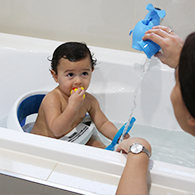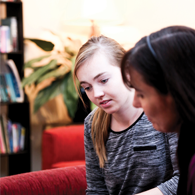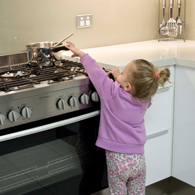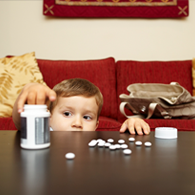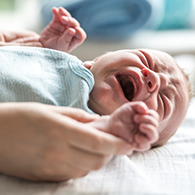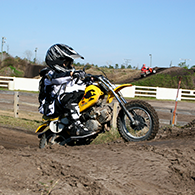Heaters and fireplaces
What are heaters and fireplaces?
Heaters and fireplaces give warmth in the home. Heaters include electric, oil-filled, gas and less commonly today, kerosene heaters. Fireplaces include potbelly stoves and other solid fuel burners. Some operate with open flames while others generate heat that can be controlled.
How are children injured?
Burns
- Children can sustain burn injuries if they come into contact with the hot surface of a heating appliance, hot coals or flames.
- Children can also sustain burn injuries if a heater or fireplace starts a fire by coming into contact with flammable items such as night clothes, curtains, paper, carpet etc.
- Faulty heating appliances and damaged electrical cables can cause electrical burns and electrocution.
Poisoning
- Carbon monoxide (CO) poisoning can happen if outdoor heaters or barbecues are used inside or in enclosed spaces. Poorly installed and vented heaters can also lead to CO poisoning.
Respiratory issues
- Exposure to air pollutants from wood and gas heaters that are not flued can cause respiratory irritations, worsen asthma and increase the risk of lung disease.1 Unflued gas heaters can produce harmful air pollutants including CO and nitrogen dioxide (NO2).4 Flued gas heater vents take these pollutants outside of the home. Children with asthma are more at risk of the effects of CO and NO2.
How common are these injuries?
In 2013-2014, 0-4 year olds accounted for 17.7% of hospitalised burn injury in Australia and had the highest rate of hospitalised burn injury. Exposure to smoke, fire & flames accounted for 6.8% of burns in children aged 0 - 4 years and contact with heat or hot substances accounted for 31.2% of burns in this age group.2
Winter is the most common time for fires in the home, with 43% of fire fatalities occurring in winter.3 Common causes of home fires include faulty electric blankets, heaters, open fires, lint left in clothes dryer filters, cooking left unattended, and faults caused by overloaded power boards.
What are the laws, regulations or standards for heaters?
In NSW, all electrical goods sold must meet the requirements of the Electricity (Consumer Safety) Act 2004 (NSW) and its Regulations. This legislation covers the distribution of safe electrical appliances and other electrical goods which must be tested and approved before they can be sold. All approved electrical goods must display an approval mark. Visit Fairtrading NSW to see examples of these approval marks.
Outdoor heaters
In NSW a ban applies to the sale of specific types of outdoor heaters with an integral gas cylinder where the heating surface is less than 1.8 metres from the ground. The low height is considered a burns risk to children and may also lead to them being incorrectly used indoors.
Room heaters
The standards that apply to electric and gas heaters are:
- AS/NZS 60335.2.30: 2015 - Household and similar electrical appliances - Safety Particular requirements for room heaters (IEC 60335-2-30 Ed 5, MOD)
- AS/NZS 60335.2.102: 2018 – Household and similar electrical appliances - Safety Particular requirements for gas, oil and solid-fuel burning appliances having electrical connections (IEC 60335-2-102 Ed 2, MOD).
- AS/NZS 5263.1.8 2016 – Decorative effect gas appliances.
- AS 4553 Gas space heating appliances.
- AS/NZS 2286:2001 - Space heaters – Secondary guards.
Gas heaters
Gas appliances for sale in NSW, including gas heaters, must carry a recognised certification label. Images of these labels are shown below.


Wood heaters
In NSW, council approval is required to install a wood heater or fireplace as per Section 68 of the Local Government Act 1993 (NSW). This is to make sure they are installed and operated correctly.
All wood fireplaces made after 1992 must comply with the following Australian Standards:
- AS/NZS 4013: 2014 - Domestic solid fuel burning appliances—Method for determination of flue gas emission.
- AS/NZS 2918: 2018 Domestic solid fuel burning appliances – Installation.
First aid for burns
- Use cool running water on a burn for 20 minutes.
This will stop the burning process, cool the burn and can be useful within three hours of a burn.
- Call 000 or seek medical help if you are unsure.
- Never use ice, iced water, cream, toothpaste or butter on a burn as they can make the burn worse.
- Burn creams do not cool the burn and should not be used instead of cool running water.
- Remove clothing and jewelry from burned area if safe to do so.
- To learn more about first aid for burns visit Kids Health | CPR-Resuscitation
Remember:
- Install a guard around heaters or fireplaces to prevent children contacting hot surfaces or materials getting close enough to catch fire.
- Do not place clothing or other washing items over a heater or fireplace to dry, as they can catch fire.
- Keep heaters and fireplaces in a safe working condition and replace missing parts. Never operate something that is damaged.
- Install and maintain at least one smoke detector on each floor of your home.
- Electric heaters
- Buy a heater that meets the applicable Australian Standard and carries a recognised approval mark.
- Use heaters on a level and stable surface never place them on elevated surfaces such as cabinets and tables.
- Position heaters where they cannot be knocked over or block your exit in case of fire and at least one metre away from anything that might catch fire such as clothing, furniture or curtains.
- Avoid using extension cords and do not overload power points or power boards.
- Switch off heating appliances when leaving the house or when sleeping.
- Keep electric heaters and appliances away from water to prevent electrocution and never touch an electric heater if you are wet.
Gas heaters
- Only use flued gas heaters.
- Outdoor heaters
- Never use an outdoor heater indoors or in an enclosed space.
- Wood fireplaces
- Check that your fireplace complies with the relevant Australian/New Zealand Standard
- Regularly clean your chimney.
- Never leave an open fire burning or smoldering overnight.
- Get approval from your local council to install a wood heater and have it installed by a qualified tradesperson.
References
- NSW Health (2012) Wood burning heaters and your health. Available from: http://www.health.nsw.gov.au/environment/factsheets/Pages/wood-smoke.aspx
- Australian Institute of health and Welfare (2014). Hospitalised Burn Injuries 2301-14. Available from: https://www.aihw.gov.au/reports/injury/hospitalised-burn-injuries-australia-2013-14/contents/table-of-contents
- Fire and Rescue NSW (n.d) Home Fire Safety. Available from: http://www.fire.nsw.gov.au/page.php?id=879
- NSW Health (2004) Un-flued gas heaters. Available from: http://www.health.nsw.gov.au/environment/factsheets/Pages/unflued-gas-heaters.aspx
